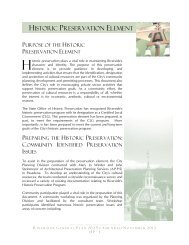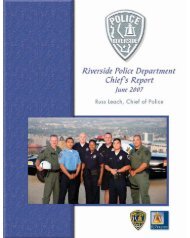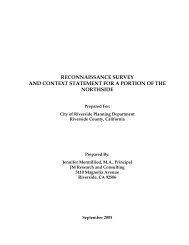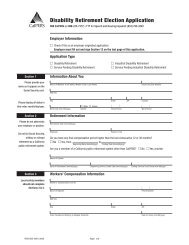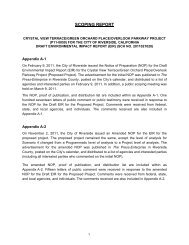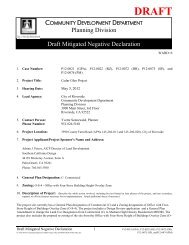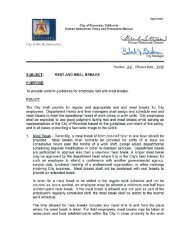Airport Master Plan - City of Riverside
Airport Master Plan - City of Riverside
Airport Master Plan - City of Riverside
Create successful ePaper yourself
Turn your PDF publications into a flip-book with our unique Google optimized e-Paper software.
eral aviation will not change dramatically.<br />
The FAA recognizes that a major<br />
risk to continued economic growth<br />
is upward pressure on commodity<br />
prices, including the price <strong>of</strong> oil. However,<br />
the FAA economic models predict<br />
a 15 percent increase in oil prices in<br />
2006, followed by a decline <strong>of</strong> 0.6 percent<br />
to 2.5 percent annually between<br />
2007 and 2012, then rising by just<br />
over 2.0 percent annually for the balance<br />
<strong>of</strong> the forecast period.<br />
The FAA projects the active general<br />
aviation aircraft fleet to increase at an<br />
average annual rate <strong>of</strong> 1.4 percent<br />
through 2020, increasing from 224,352<br />
in 2005, to 274,914 in 2020. This<br />
growth is depicted on Exhibit 2A.<br />
FAA forecasts identify two general<br />
aviation economies that follow different<br />
market patterns. The turbojet<br />
fleet is expected to increase at an average<br />
annual rate <strong>of</strong> 6.0 percent, increasing<br />
from 9,823 in 2005, to 22,797<br />
in 2020. Factors leading to this substantial<br />
growth include expected<br />
strong U.S. and global economic<br />
growth, the continued success <strong>of</strong> fractional-ownership<br />
programs, the introduction<br />
<strong>of</strong> the VLJ/microjet, and a continuation<br />
<strong>of</strong> the shift from commercial<br />
air travel to corporate/business air<br />
travel by business travelers and corporations.<br />
Piston-powered aircraft<br />
(single and multi-engine) are projected<br />
to grow at 0.3 percent annually. Piston-powered<br />
helicopters are forecast to<br />
grow at 5.7 percent annually, while<br />
turbine helicopters are forecast to<br />
grow 2.1 percent annually.<br />
Aircraft utilization rates are projected<br />
to increase through the year 2020.<br />
The number <strong>of</strong> general aviation hours<br />
flown is projected to increase at 3.4<br />
percent annually. Similar to active<br />
aircraft projections, there is projected<br />
disparity between piston and turbine<br />
aircraft hours flown. Hours flown in<br />
turbine aircraft are expected to increase<br />
at 6.1 percent annually, compared<br />
with 1.3 percent for pistonpowered<br />
aircraft. Jet aircraft are projected<br />
to increase at 9.4 percent annually,<br />
while fixed wing pistonpowered<br />
aircraft are projected to grow<br />
1.0 percent annually through 2020.<br />
The total pilot population is projected<br />
to increase by 38,000 through 2020,<br />
from an estimated 467,745 in 2005, to<br />
506,097, which represents an average<br />
annual growth rate <strong>of</strong> .08 percent.<br />
The student pilot population is forecast<br />
to increase at an annual rate <strong>of</strong><br />
1.2 percent over the forecast period,<br />
reaching a total <strong>of</strong> 100,181 in 2020.<br />
Growth rates for the other pilot categories<br />
over the forecast period are as<br />
follows: airline transport pilots, up 0.2<br />
percent; recreational pilots declining<br />
0.1 percent annually; rotorcraft only,<br />
up 3.1 percent annually; commercial<br />
pilots up 0.8 percent annually, private<br />
pilots show a zero growth rate, and<br />
glider only, up 0.4 percent. The decline<br />
in recreational and private pilots<br />
is the result <strong>of</strong> the expectation that<br />
most new general aviation pilots will<br />
choose to obtain the Sport Pilot license<br />
instead.<br />
Over the past several years, the general<br />
aviation industry has launched a<br />
series <strong>of</strong> programs and initiatives<br />
whose main goals are to promote and<br />
assure future growth within the industry.<br />
“No <strong>Plan</strong>e, No Gain” is an advocacy<br />
program created in 1992 by the<br />
General Aviation Manufacturers Association<br />
(GAMA) and the National<br />
2-7



